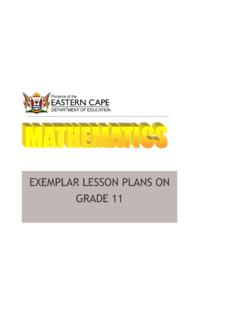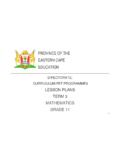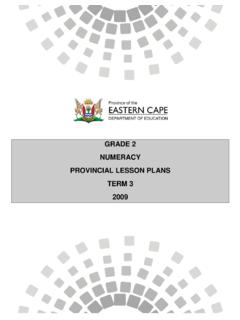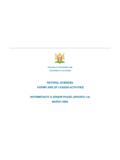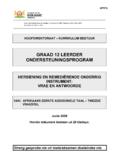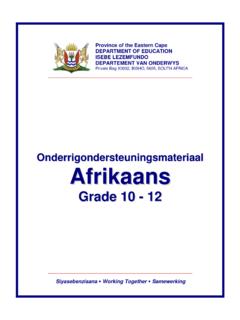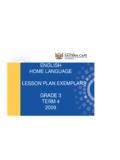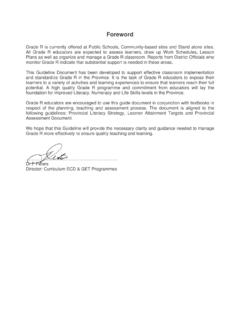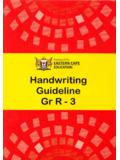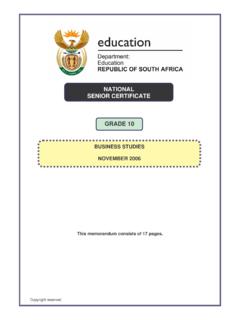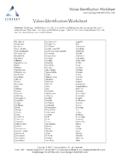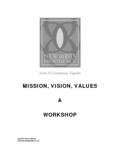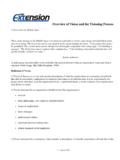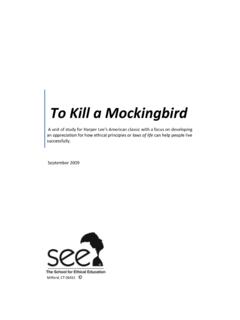Transcription of PROVINCE OF THE EASTERN CAPE EDUCATION - …
1 PROVINCE OF THE EASTERN cape EDUCATION DIRECTORATE: FET CURRICULUM FET PROGRAMMES LESSON PLANS TERM 3 LIFE SCIENCES GRADE 10 FOREWORD The following Grade 10, 11 and 12 Lesson Plans were developed by Subject Advisors during May 2009. Teachers are requested to look at them, modify them where necessary to suit their contexts and resources. It must be remembered that Lesson Plans are working documents, and any comments to improve the lesson plans in this document will be appreciated.
2 Teachers are urged to use this document with the following departmental policy documents: Subject Statement; LPG 2008; SAG 2008 and Provincial CASS Policy / Guidelines. Lesson planning is the duty of each and every individual teacher but it helps when teachers sometimes plan together as a group. This interaction not only helps teachers to understand how to apply the Learning Outcomes (LOs) and Assessment Standards (ASs) but also builds up the confidence of the teachers in handling the content using new teaching strategies.
3 It must please be noted that in order to help teachers who teach across grades and subjects, an attempt has been made to standardise lesson plan templates and thus the new template might not resemble the templates used in each subject during the NCS training. However, all the essential elements of a lesson plan have been retained. This change has been made to assist teachers and lighten their administrative load. Please note that these lesson plans are to be used only as a guide to complete the requirements of the Curriculum Statements and the work schedules and teachers are encouraged to develop their own learner activities to supplement and /or substitute some of the activities given here (depending on the school environment, number and type of learners in your class, the resources available to your learners, etc).
4 Do not forget to build in the tasks for the Programme of Assessment into your Lesson Plans. Strengthen your efforts by supporting each other in clusters and share ideas. Good Luck with your endeavours to improve Teaching, Learning and Assessment. SUBJECT: LIFE SCIENCES GRADE: 10 LESSON PLAN 1 TERM 3 TIME: 20hrs Focus Learning Outcome/s: LO2 AS 1, 2 & 3 Integrated Life Sciences LOs and ASs: LO1# AS1, AS2, AS3, LO2# AS1,AS2,AS3 and LO3# AS1, AS2, AS3 Possible integration with other subjects Physical Sciences, English, Agricultural Sciences Knowledge Area Life at the Molecular, Cellular and Tissues Level Prior Knowledge Cell Structure and Function Topic Cells.
5 The Basic Unit of Life Links to next lesson Energy Transformation sustain Life LEARNING OUTCOME 1: Scientific Inquiry & Problem solving Skills. LEARNING OUTCOME 2: Constructs & Application of Life Sciences Knowledge. LEARNING OUTCOME 3: Life Sciences and its relationships to Technology, Society and the Environment. AS1: Learner identifies and questions phenomena and plans an investigation AS1: Learner accesses knowledge AS1: Learner explores & evaluates scientific ideas of past and present cultures AS2: Learner conducts an investigation by collecting and manipulating data AS2: Learner interprets and makes meaning of knowledge AS2: Learner compares & evaluates uses and developments of resources and their products & their impact on the environment & society.
6 AS3: Learners analyses, synthesizes, evaluates data and communicates findings AS3: Learner shows understanding of how Life Sciences knowledge is applied in everyday life AS3: Learner compares the influence of different beliefs, attitudes and values on scientific knowledge TEACHING ACTIVITIES LEARNERS ACTIVITIES RESOURCES ASSESSMENT DATE COMPLETED Activity 1: Transport/ movement across membranes: LO1# AS1, AS2 LO2# AS 1, AS 2 Ask learners about their understanding of the processes diffusion, osmosis and active transport. Consolidates discussions.
7 Demonstrates and explains how the processes of diffusion, osmosis and active transport take place by means of experimentation Diffusion: Teacher hands out worksheets with instructions. He can also splash ether/ or spray DOOM on the Respond to questions and come up with explanation of terms. Practical Investigation: Learner groups measure the rate of diffusion of potassium permanganate crystals in two different solutions (water and a sugar solution), or may measure the rate various chemicals take to dissolve in different types of Test tubes, chemicals, liquids, worksheet, workbook, stopwatch, etc.
8 Formal assessment: Memorandum blackboard to illustrate the speed of gaseous diffusion to the learners. liquids. Individual reporting of experiment. TEACHING ACTIVITIES LEARNERS ACTIVITIES RESOURCES ASSESSMENT DATE COMPLETED Osmosis: Teachers demonstrates the setup of the apparatus and the investigation procedure. Teacher explains the following terminology non-permeable, differentially permeable (semi) and fully permeability, solutions, concentrations Teacher instructs the learners to do the practical investigation as on the worksheet Learners observe and make notes.
9 Practical investigation: Learners investigate the direction of water movement between two different solutions separated by means of a differentially permeable membrane ( egg membrane, potato, dialysis tubing or a frog skin). Individual reporting of experiment Retort stand & clamps, cotton/ string, water, sugar, egg membrane, rubber bands, spatula/ teaspoon, 2 beakers, thistle funnel & spatula Formal assessment: Memorandum Active Transport: Teacher explains active transport highlighting important terminology concentration gradient and energy dependency by means of examples.
10 Teachers instructs the learners to construct a table illustrating the properties of the different processes above Learners observe and make notes. Learners tabulate the properties of the different processes diffusion, osmosis and active transport Workbooks Informal assessment : Question & Answer (Q & A) Informal Assessment: Test Activity 2: Cell division mitosis: LO 1# AS2 & AS3, LO2# AS1, AS2, LO3# AS1, AS3 Use suitable resources to explain the cell cycle. Teacher explains the importance of mitosis, the process, as well as the structure of a chromosome.
